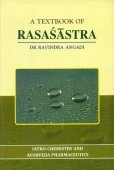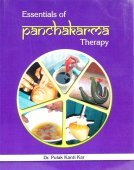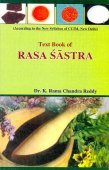Aushadha, Auṣadha: 24 definitions
Introduction:
Aushadha means something in Hinduism, Sanskrit, Jainism, Prakrit, the history of ancient India, Marathi, Hindi. If you want to know the exact meaning, history, etymology or English translation of this term then check out the descriptions on this page. Add your comment or reference to a book if you want to contribute to this summary article.
The Sanskrit term Auṣadha can be transliterated into English as Ausadha or Aushadha, using the IAST transliteration scheme (?).
Alternative spellings of this word include Aushadh.
In Hinduism
Ayurveda (science of life)
Nighantu (Synonyms and Characteristics of Drugs and technical terms)
Source: Wisdom Library: Raj Nighantu1) Auṣadha (औषध) refers to “medicinal drugs”, as defined in the 13th-century Raj Nighantu or Rājanighaṇṭu (an Ayurvedic encyclopedia). Accordingly, “all the names of a drug (auṣadha) or a substance (dravya) can not be included in one single glossary since these are spoken differently in different languages, like Sanskrit, Prakrit and Apabhramsa and at different places. [...] One should enquire about the names, characteristics and actions of the drugs (auṣadha) from cow-herds, shepherds, mountaineers, hermits, travelers and from those who often scan the forests. Only after ascertaining all these factors about a drug, one should go for its use”.
The names of medicinal drugs (auṣadha) and substances (dravya) are classified according to of seven factors:
- Rūḍhita (traditional use),
- Svabhāva or Svabhāvata (by natural properties),
- Deśyokti (by local or native names),
- Lāñchana (by characteristic sings or marks),
- Upama (by simile, analogy or resemblance),
- Vīrya (by potency and efficacy),
- Ādideśa (the same drug name differently at different places).
Accordingly, “these seven are the everlasting sources of the names i.e. names spoken in different regions or countries such as Kāśmīraja, Kāmbojī, Magadhodbhavā or Vālhikā”.
2) Auṣadha (औषध) or Oṣadhi refers to “[those plants] which perishes after ripening of fruits” and represents one of the five kinds of aṅkura or “substances (dravya) produced (ja) through a sprout (aṅkura)”, as defined in the first chapter (ānūpādi-varga) of the 13th-century Raj Nighantu or Rājanighaṇṭu (an Ayurvedic encyclopedia). The Anūpādi-varga covers some 16 major topics regarding land and vegetations (e.g., Auṣadha).
Kalpa (Formulas, Drug prescriptions and other Medicinal preparations)
Source: Shodhganga: Edition translation and critical study of yogasarasamgrahaAuṣadha (औषध) is another name for “Ativiṣā” and is dealt with in the 15th-century Yogasārasaṅgraha (Yogasara-saṅgraha) by Vāsudeva: an unpublished Keralite work representing an Ayurvedic compendium of medicinal recipes. The Yogasārasaṃgraha [mentioning auṣadha] deals with entire recipes in the route of administration, and thus deals with the knowledge of pharmacy (bhaiṣajya-kalpanā) which is a branch of pharmacology (dravyaguṇa).
Unclassified Ayurveda definitions
Source: archive.org: Vagbhata’s Ashtanga Hridaya Samhita (first 5 chapters)Auṣadha (औषध) refers to “medicine”, and is mentioned in verse 1.28 of the Aṣṭāṅgahṛdayasaṃhitā (Sūtrasthāna) by Vāgbhaṭa.
According to Aruṇadatta (Aṣṭāṅgahṛdayasaṃhitā V.6.1 sqq.):
Source: gurumukhi.ru: Ayurveda glossary of terms“As medicine is recommended (anything) grown in a desert or moderate region (a region that is) even, of good soil, clean, devoid of cremation grounds, topes, temples, chasms, and ant-hills, soft, of auspicious water, covered with kusa and geranium grass, untilled by the plough, (and) unassailed by bigger trees”
Auṣadha (औषध):—Medicine / drug

Āyurveda (आयुर्वेद, ayurveda) is a branch of Indian science dealing with medicine, herbalism, taxology, anatomy, surgery, alchemy and related topics. Traditional practice of Āyurveda in ancient India dates back to at least the first millenium BC. Literature is commonly written in Sanskrit using various poetic metres.
Purana and Itihasa (epic history)
Source: archive.org: Shiva Purana - English TranslationAuṣadha (औषध) refers to the “medicine”, according to the Śivapurāṇa 2.3.31 (“Description of Śiva’s magic”).—Accordingly, as Śiva (in disguise of a Brahmin) said to the Lord of Mountains: “[...] For the marriage of Pārvatī, He is not at all a deserving person. On hearing of this, the general public will smile in derision. O lord of mountains, see for yourself. He has not a single kinsman. You are the storehouse of great gems and jewels. He has no assets at all. O lord of mountains, you shall consult your kinsmen, sons, wife and wise counsellors, except Pārvatī. O lord of mountains, the medicine (auṣadha) does not appeal at all to the patient. Wrong diet that brings about great defects always appeals to him”.
Source: Shodhganga: The saurapurana - a critical studyAuṣadha (औषध) refers to one of the various kinds of articles used for donation, according to the 10th century Saurapurāṇa: one of the various Upapurāṇas depicting Śaivism.—Accordingly, the tenth chapter contains the praise and classification of donations. It narrates the characteristics of proper recipients and the results of giving different kinds of articles like Bhūmi, Vidyā, Anna, Jala, Tila, Vāsa, Dīpa, Yāna, Śayyā, Dhānya, Aśva, Śāka, Indhana, Chatra, Auṣadha, Go, etc.

The Purana (पुराण, purāṇas) refers to Sanskrit literature preserving ancient India’s vast cultural history, including historical legends, religious ceremonies, various arts and sciences. The eighteen mahapuranas total over 400,000 shlokas (metrical couplets) and date to at least several centuries BCE.
Vaishnavism (Vaishava dharma)
Source: Brill: Śaivism and the Tantric Traditions (vaishnavism)Auṣadha (औषध) refers to “medicine (that stills the fluctuations of the mind)”, according to the Vedānta Deśika’s Yatirājasaptati.—This view of Rāmānuja’s central role in the establishment of a new, Viśiṣṭādvaita Vedānta is the second central motif in the poem. Thus, even while we also have verses in the poem that, like in the Irāmāṉuja Nūṟṟantāti, echo the sentiments of taking refuge at the feet of Rāmānuja, such as verses Verse 18, where those who take refuge at the feet of Yatipati become free of sin or Verse 20, where the feet are a refuge compared to medicine (auṣadha) that stills the fluctuations of the mind, it becomes clear that the framework of the poem does not allow for a predominant focus on the analogy between Rāmānuja and Kṛṣṇa nor that his feet themselves are the predominant upāya for mokṣa.

Vaishnava (वैष्णव, vaiṣṇava) or vaishnavism (vaiṣṇavism) represents a tradition of Hinduism worshipping Vishnu as the supreme Lord. Similar to the Shaktism and Shaivism traditions, Vaishnavism also developed as an individual movement, famous for its exposition of the dashavatara (‘ten avatars of Vishnu’).
Sports, Arts and Entertainment (wordly enjoyments)
Source: archive.org: Syainika Sastra of Rudradeva with English Translation (art)Auṣadha (औषध) refers to the “remedies (of the diseases)” (of the Hawk), according to the Śyainika-śāstra: a Sanskrit treatise dealing with the divisions and benefits of Hunting and Hawking, written by Rājā Rudradeva (or Candradeva) in possibly the 13th century.—Accordingly, [while discussing the treatment of hawks]: “[...] To those who are well-versed in the art of hawking, well-trained birds give great delight. Now, to the misfortune of men, diseases prevail among the birds for spoiling men’s enjoyment; therefore these diseases are enumerated and their respective remedies (auṣadha) prescribed. [...]”.

This section covers the skills and profiencies of the Kalas (“performing arts”) and Shastras (“sciences”) involving ancient Indian traditions of sports, games, arts, entertainment, love-making and other means of wordly enjoyments. Traditionally these topics were dealt with in Sanskrit treatises explaing the philosophy and the justification of enjoying the pleasures of the senses.
General definition (in Hinduism)
Source: Wisdom Library: Hinduism1. Sanskrit term used in Ayurveda, roughly meaning 'made of herbs', 'medicinal herb', 'remedy', 'drug' or 'medicine'.
2. Sanskrit noun meaning 'vessel for herbs'
In Jainism
General definition (in Jainism)
Source: The University of Sydney: A study of the Twelve ReflectionsAuṣadha (औषध) refers to “medicine” (as opposed to Anauṣadha—‘ absence of any medicine’), according to the 11th century Jñānārṇava, a treatise on Jain Yoga in roughly 2200 Sanskrit verses composed by Śubhacandra.—Accordingly, “Fool, perceiving this multitude of objects that is continually transitory and you do not understand. This is a planet without any medicine (anauṣadha-graha—grahaḥ ko'yam anauṣadhaḥ)”.

Jainism is an Indian religion of Dharma whose doctrine revolves around harmlessness (ahimsa) towards every living being. The two major branches (Digambara and Svetambara) of Jainism stimulate self-control (or, shramana, ‘self-reliance’) and spiritual development through a path of peace for the soul to progess to the ultimate goal.
India history and geography
Source: Cologne Digital Sanskrit Dictionaries: Indian Epigraphical GlossaryAuṣadha.—(EI 24), medicine. Note: auṣadha is defined in the “Indian epigraphical glossary” as it can be found on ancient inscriptions commonly written in Sanskrit, Prakrit or Dravidian languages.

The history of India traces the identification of countries, villages, towns and other regions of India, as well as mythology, zoology, royal dynasties, rulers, tribes, local festivities and traditions and regional languages. Ancient India enjoyed religious freedom and encourages the path of Dharma, a concept common to Buddhism, Hinduism, and Jainism.
Languages of India and abroad
Marathi-English dictionary
Source: DDSA: The Molesworth Marathi and English Dictionaryauṣadha (औषध).—n (S) A drug; any medicine or medicament. auṣadha or auṣadhēṃ karaṇēṃ To employ medicines. auṣadhālā nasaṇēṃ (Not to be enough even for medicine. ) To be wanting altogether.
Source: DDSA: The Aryabhusan school dictionary, Marathi-Englishauṣadha (औषध).—n A drug; any medicine. auṣadhālā nasaṇēṃ Be wanting altogether.
Marathi is an Indo-European language having over 70 million native speakers people in (predominantly) Maharashtra India. Marathi, like many other Indo-Aryan languages, evolved from early forms of Prakrit, which itself is a subset of Sanskrit, one of the most ancient languages of the world.
Sanskrit dictionary
Source: DDSA: The practical Sanskrit-English dictionaryAuṣadha (औषध).—a. (-dhī f.) [औषधि-अण् (auṣadhi-aṇ)] Consisting of herbs.
-dham 1 A herb; herbs taken collectively.
2) A medicament, medicinal drug, medicine in general.
3) A vessel for herbs.
4) A mineral.
5) Name of Viṣṇu.
6) Counter-action, prevention; अतिक्रुधं निषधमनौषधं जनः (atikrudhaṃ niṣadhamanauṣadhaṃ janaḥ) Śiśupālavadha 17.7.
Source: Cologne Digital Sanskrit Dictionaries: Shabda-Sagara Sanskrit-English DictionaryAuṣadha (औषध).—n.
(-dhaṃ) A medicament, a drug, any herd, mineral, &c. used in medicine. E. auṣadhi an annual plant, and aṇ aff.
Source: Cologne Digital Sanskrit Dictionaries: Benfey Sanskrit-English DictionaryAuṣadha (औषध).—i. e. oṣadhi + a, m. and n. A medicine, [Mānavadharmaśāstra] 8, 324.
Source: Cologne Digital Sanskrit Dictionaries: Cappeller Sanskrit-English DictionaryAuṣadha (औषध).—[adjective] consisting of herbs. [neuter] a herb or herbs (collect.); simples, medicine.
Source: Cologne Digital Sanskrit Dictionaries: Monier-Williams Sanskrit-English Dictionary1) Auṣadha (औषध):—mf(ī)n. ([from] oṣadhi), consisting of herbs, [Śatapatha-brāhmaṇa vii]
2) n. herbs collectively, a herb, [Śatapatha-brāhmaṇa; Aitareya-brāhmaṇa; Kātyāyana-śrauta-sūtra] etc.
3) herbs used in medicine, simples, a medicament, drug, medicine in general, [Manu-smṛti; Mahābhārata; Raghuvaṃśa] etc.
4) a mineral, [Horace H. Wilson]
5) a vessel for herbs.
Source: Cologne Digital Sanskrit Dictionaries: Yates Sanskrit-English DictionaryAuṣadha (औषध):—(dhaṃ) 1. n. A medicament.
Source: DDSA: Paia-sadda-mahannavo; a comprehensive Prakrit Hindi dictionary (S)Auṣadha (औषध) in the Sanskrit language is related to the Prakrit words: Osaḍha, Osaha.
[Sanskrit to German]
Sanskrit, also spelled संस्कृतम् (saṃskṛtam), is an ancient language of India commonly seen as the grandmother of the Indo-European language family (even English!). Closely allied with Prakrit and Pali, Sanskrit is more exhaustive in both grammar and terms and has the most extensive collection of literature in the world, greatly surpassing its sister-languages Greek and Latin.
Hindi dictionary
Source: DDSA: A practical Hindi-English dictionaryAuṣadha (औषध) [Also spelled aushadh]:—(nm) a medicine, drug.
...
Kannada-English dictionary
Source: Alar: Kannada-English corpusAuṣadha (ಔಷಧ):—
1) [noun] any of the herbs or plants in general.
2) [noun] a substance or preparation used in treating a disease or in removing the pain, sprain, etc.; a medicine.
3) [noun] ಔಷಧಮಾಡು [aushadhamadu] auṣadha maḍu to treat with a medicine. 2. to make, prepare a medicine; ಔಷಧಕ್ಕೆ ಬೇಕೆಂದರೂ ಇಲ್ಲ [aushadhakke bekemdaru illa] auṣadhakke bēkendarū illa (said about the availability of a thing) absolutely not available.
Kannada is a Dravidian language (as opposed to the Indo-European language family) mainly spoken in the southwestern region of India.
See also (Relevant definitions)
Starts with (+4): Aushadhabala, Aushadhacarya, Aushadhagrahana, Aushadhagrantha, Aushadhaharana, Aushadhakalpa, Aushadhakalpagrantha, Aushadhakalpana, Aushadhakalpanadhyaya, Aushadhalay, Aushadhalaya, Aushadhamamjari, Aushadhamgol, Aushadhapani, Aushadhapeshaka, Aushadhaprakara, Aushadhaprayoga, Aushadharaja, Aushadhashastra, Aushadhashastrajna.
Ends with (+18): Anaushadha, Divyaushadha, Duraushadha, Gamdaushadha, Garudaushadha, Hasuraushadha, Jivanaushadha, Kandaushadha, Kashthaushadha, Khadataraaushadha, Mahaushadha, Mantraushadha, Mutrotpadaka-aushadha, Nanaushadha, Natiaushadha, Nayanaushadha, Netraushadha, Niraushadha, Palitaushadha, Panyaushadha.
Full-text (+84): Osadha, Aushadhi, Mahaushadha, Aushadhapeshaka, Aushadhiya, Aushadhavali, Trinaushadha, Netraushadha, Jivanaushadha, Takila, Aushadhaprayoga, Aushadhaprakara, Aushadhakalpagrantha, Mutrotpadaka-aushadha, Anaushadha, Avushatam, Paramartha, Aushatam, Rasayani Aushadha, Juluma.
Relevant text
Search found 23 books and stories containing Aushadha, Auṣadha, Ausadha; (plurals include: Aushadhas, Auṣadhas, Ausadhas). You can also click to the full overview containing English textual excerpts. Below are direct links for the most relevant articles:
Women in the Atharva-veda Samhita (by Pranab Jyoti Kalita)
6f. Hymns to Allay Jealousy < [Chapter 2 - The Strīkarmāṇi Hymns of the Atharvaveda]
6. Goddess Āsurī < [Chapter 4 - Female Deities and the Glorification of Women in the Atharvaveda]
Shrimad Bhagavad-gita (by Narayana Gosvami)
Verses 9.16-19 < [Chapter 9 - Rāja-guhya-yoga (Yoga through the most Confidential Knowledge)]
The Agni Purana (by N. Gangadharan)
Chapter 317 - The different kinds of mantras of Śiva
Chapter 284 - Narration of sacred formulas that are medicinal (mantra-rūpa-auṣadha)
Chaitanya Bhagavata (by Bhumipati Dāsa)
Verse 2.20.69 < [Chapter 20 - The Glories of Murāri Gupta]
Verse 1.9.89 < [Chapter 9 - Nityānanda’s Childhood Pastimes and Travels to Holy Places]
Verse 1.9.76 < [Chapter 9 - Nityānanda’s Childhood Pastimes and Travels to Holy Places]
Brihad Bhagavatamrita (commentary) (by Śrī Śrīmad Bhaktivedānta Nārāyana Gosvāmī Mahārāja)
Verse 1.4.83 < [Chapter 4 - Bhakta (the devotee)]
Bhajana-Rahasya (by Srila Bhaktivinoda Thakura Mahasaya)
Text 3 < [Chapter 3 - Tṛtīya-yāma-sādhana (Pūrvāhna-kālīya-bhajana–niṣṭhā-bhajana)]
Related products
(+1 more products available)





